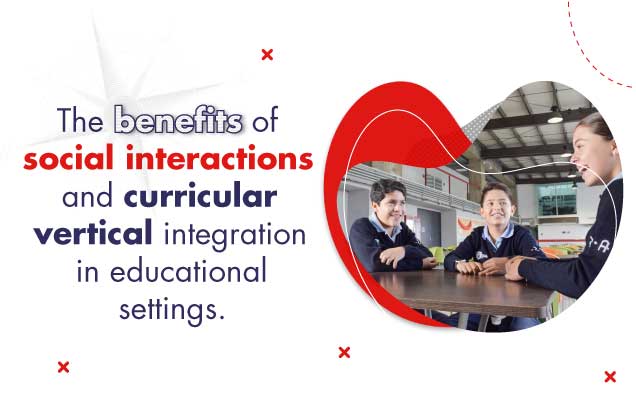
The benefits of social interactions and curricular vertical integration in educational settings
Social interactions are everyday life experiences that take place in settings shared by a group of individuals. They are also a means that facilitates the learning-teaching process as well as one that fosters the social construction of knowledge.
Social interaction plays an important role in the learning process given that it allows for the development of human skills, such as language and cognition, which are essential in our daily lives. Furthermore, communication becomes the manner through which humans engage in and mediate their social interactions. Finally, what we learn, come to understand, and know is due in large part to our social interactions.
A pedagogical approach that favors a socially interactive classroom environment is of the utmost importance for student development. First, making collaborative learning experiences an everyday part of school life will result in cohesive and community-minded classroom settings. In addition, well-designed social interactions will lessen the impact of geographical differences as well as reduce personal distance.
The American School is a wonderful multicultural community made up of more than 40 nationalities. This multicultural wealth fosters a global mindset in our students, the development of communication and interpersonal skills from a young age as well as an opportunity for community members to communicate in numerous languages.
Being part of a multicultural community means that our students not only develop a global mindset that allows them to understand their place in the world, encourages their desire to learn about other cultures, and leads to a willingness to understand additional points of view, even those that differ. Students’ daily social interactions help create a sense of community that not only builds confidence in themselves and their settings, but also lead to the development of interpersonal skills that are critical for their growth and future.
The American School is a Pre-K-12 institution whose programs reflect a curricular vertical integration. Said integration means that students will receive a well-rounded, world class education starting in their early years and all the way up to the moment they graduate and embark on their university journeys.
References
Arias, L. (2009). Las Interacciones Sociales que se Desarrollan en los Salones
de Clase y su Relación con la Práctica Pedagógica que realiza el Docente
en el Aula. Universidad Nacional de Heredia.
Navalpotro, J. (2017). Verticalidad Pedagógica. El reto de las estructuras
escolares.
Pérez Alcalá, M. (2009). La comunicación y la interacción en contextos virtuales
de aprendizaje. Apertura, 1(1).
http://www.udgvirtual.udg.mx/apertura/index.php/apertura/article/view/15/18
Rizo, M. (2007). Interacción y comunicación en entornos educativos: Reflexiones
teóricas, conceptuales y metodológicas. Universidad Autónoma de la
Ciudad de México.
Santos Gómez, M. (2017). De la verticalidad a la horizontalidad. Reflexiones
para una educación emancipadora. Realidad: Revista de Ciencias
Sociales y Humanidades, 107, pp. 39-64.
https://doi.org/10.5377/realidad.v0i107.3869